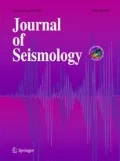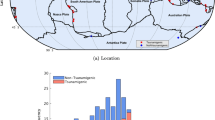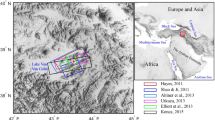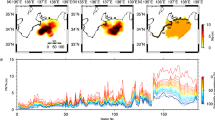Abstract
The present work aims at building a non-stationary random field model for the slip distribution on the rupture plane. The estimates are arrived based on 230 slip fields available in the SRCMOD database. The evaluation is performed by segregating and quantifying the trend and fluctuation components of the field. Here, the trend portion of the slip is extracted by fitting a 2D elliptical Gaussian surface. The remaining fluctuation part is observed to be stationary following a normal distribution. Further, we propose scaling relations as a function of magnitude for all the unknowns in trend and fluctuation part of the field. Furthermore, an additive model to generate a slip field for a given magnitude combining the deterministic trend part and randomly generated fluctuation part is also developed in the study. Ground motion simulations performed with the components of the slip field showed that the trend portion controls the low frequency, and the fluctuation portion influences the high-frequency characteristics of ground motion. The model developed from the study can be used to generate an ensemble of slip fields for ground motion simulations.
















Similar content being viewed by others
References
Akaike H (1973) Information theory and the maximum likelihood principle. in 2nd international symposium on information theory (bn petrov and f. cs ä ki eds.) Akademiai Ki à do, Budapest. Google Scholar
Aki K, Richards PG (1980) Quantative seismology: theory and methods. New York, pp 801
Baglione E (2016) Characterization of the co-seismic slip field for large earthquakes. [Online; https://core.ac.uk/download/pdf/78374062.pdf, accessed 20-February-2019]
Bendat JS, Piersol AG (2011) Random data: analysis and measurement procedures, vol 729. Wiley, New York
Brune JN (1970) Tectonic stress and the spectra of seismic shear waves from earthquakes. J Geophys Res 75(26):4997– 5009
Dhanya J, Raghukanth STG (2019) A non-gaussian random field model for earthquake slip (under review). Journal of Seismology
Dreger DS, Huang M-H, Rodgers A, Taira T, Wooddell K (2015) Kinematic finite-source model for the 24 August 2014 South Napa, California, earthquake from joint inversion of seismic, GPS, and InSAR data. Seismol Res Lett 86(2A):327–334
Goda K, Yasuda T, Mori N, Maruyama T (2016) New scaling relationships of earthquake source parameters for stochastic tsunami simulation. Coast Eng J 58(3):1650010–1
Haskell NA (1969) Elastic displacements in the near-field of a propagating fault. Bull Seismol Soc Am 59(2):865– 908
Komatitsch D, Tromp J (1999) Introduction to the spectral element method for three-dimensional seismic wave propagation. Geophys J Int 139(3):806–822
Lavallée D, Liu P, Archuleta RJ (2006) Stochastic model of heterogeneity in earthquake slip spatial distributions. Geophys J Int 165(2):622–640
Mai PM, Beroza GC (2002) A spatial random field model to characterize complexity in earthquake slip. J Geophys Res Solid Earth 107(B11):ESE–10
Mai PM, Thingbaijam K (2014) SRCOMD: an online database of finite-fault rupture models. Seismol Res Lett 85(6):1348–1357
Mai PM, Spudich P, Boatwright J (2005) Hypocenter locations in finite-source rupture models. Bull Seismol Soc Am 95(3):965–980
Massey Jr, FJ (1951) The Kolmogorov-Smirnov test for goodness of fit. J Amer Stat Assoc 46 (253):68–78
Raghukanth STG (2010) Intrinsic mode functions of earthquake slip distribution. Adv Adapt Data Anal 2(02):193–215
Raghukanth STG, Sangeetha S (2016) A stochastic model for earthquake slip distribution of large events. Geom Nat Hazards Risk 7(2):493–521
Sepúlveda I, Liu PL-F, Grigoriu M, Pritchard M (2017) Tsunami hazard assessments with consideration of uncertain earthquake slip distribution and location. J Geophys Res Solid Earth 122 (9):7252–7271
Shinozuka M, Deodatis G (1996) Simulation of multi-dimensional Gaussian stochastic fields by spectral representation. Appl Mech Rev 49(1):29–53
Silva F, Goulet CA, Maechling PJ, Callaghan S, Jordan TH (2016) The SCEC broadband platform: open-source software for strong ground motion simulation and validation. In: AGU Fall Meeting Abstracts
Somerville P, Irikura K, Graves R, Sawada S, Wald D, Abrahamson N, Iwasaki Y, Kagawa T, Smith N, Kowada A (1999) Characterizing crustal earthquake slip models for the prediction of strong ground motion. Seismol Res Lett 70(1):59–80
Vallée M, Bouchon M (2004) Imaging coseismic rupture in far field by slip patches. Geophys J Int 156(3):615–630
Webster R, Oliver MA (2007) Geostatistics for environmental scientists. Wiley, New York
Author information
Authors and Affiliations
Corresponding author
Additional information
Publisher’s note
Springer Nature remains neutral with regard to jurisdictional claims in published maps and institutional affiliations.
Electronic supplementary material
Rights and permissions
About this article
Cite this article
Dhanya, J., Raghukanth, S.T.G. A non-stationary random field model for earthquake slip. J Seismol 24, 423–441 (2020). https://doi.org/10.1007/s10950-019-09899-y
Received:
Accepted:
Published:
Issue Date:
DOI: https://doi.org/10.1007/s10950-019-09899-y




